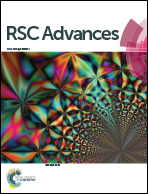Noncovalent assembly of carbon nanoparticles and aptamer for sensitive detection of ATP†
Abstract
Coupling carbon nanomaterials with biomolecular recognition events for sensor design has attracted great interest in the development of efficient bioanalytical tools. Here, based on competitive interaction of electrostatic repulsion and π–π stacking, noncovalent assembly of carboxylated carbon nanoparticles (cCNPs) with aptamer that allows sensitive and selective detection of ATP is reported. The sensor exhibits minimal background fluorescence, due to the extraordinarily high quenching efficiency of cCNPs with a spherical structure. Importantly, the quenched fluorescence is recovered with the addition of ATP within several minutes; the limit of detection is as low as 0.1 μM in the range of 0.1–300 μM, since only one end of the aptamer needs the modification, the present approach is simple and cost-effective. Furthermore, compared to the analog design based on the “pre-mixing” strategy, the assay of the “post-mixing” strategy increases by approximately 1.5 times in signal-to-background (S/B) and possesses a quicker response time (within two minutes). Depending on the spherical structure of the cCNPs and the rapid kinetic response, this assay can be expected to provide a new and ultrasensitive platform for the detection of various small molecules.


 Please wait while we load your content...
Please wait while we load your content...